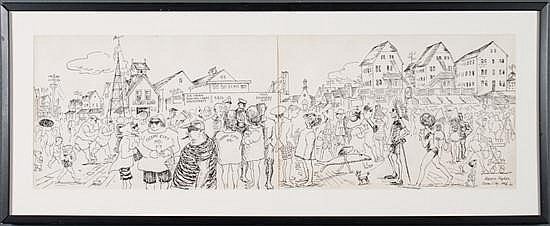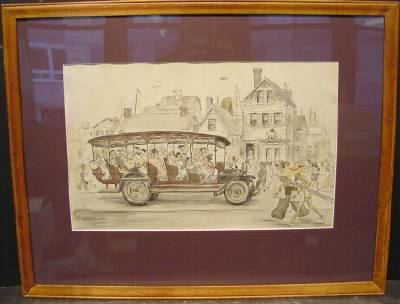Name Aaron Sopher | ||
 | ||
Died 1972, Balti, Maryland, United States | ||
WV open Aaron Sopher run
Aaron Sopher (1905–1972) was a 20th-century American artist who is known for his depictions of Baltimore, United States.
Contents

Early years
Aaron Sopher, the tenth of the thirteen children of Samuel A. Sopher and Jennie Saperstein, was born in East Baltimore, Maryland, on December 16, 1905. His father owned a small cigar factory and tobacco shop near the Baltimore harbor. Many scholars trace Sopher's artistic ability to his grandfather who sold Hebrew religious books for a living but was also an eminent sofer. Sopher attended Maryland Institute of Fine and Applied Arts now known as the Maryland Institute College of Art where he trained with Alon Bement, the director of the institution. When a new director replaced Bement, Aaron Sopher was not awarded his diploma in 1925 due to his frequent absences and lack of discipline.
Work
Sopher was a free spirit who preferred to draw people in action rather than be confined to the regulations of an educational establishment. He criticized Matisse, Mondrian, and Kandinsky, who secluded themselves in their studios and painted only beautiful, idyllic visions unlike Picasso, Grosz, and Masson who Sopher considered to be great citizens of the world in addition to being accomplished artists. As a diffident and quiet man, Sopher rejected the concept of the artist as a godlike figure. Following his stint at the Maryland Institute of Fine and Applied Arts, he worked as a freelance illustrator for The Baltimore Sun, where his drawings began to appear regularly. In 1927, Sopher received his first large commission from the newspaper to illustrate a story about the Baltimore waterfront, which was the first illustration to bring him wide recognition. Sopher then moved to New York City in 1929 where he resided until 1931. His cartoons appeared in The New Yorker, and his sketches of week were often included in The New Masses, a leftist publication devoted to social commentary.
During the Depression, Sopher felt a moral responsibility to portray in a meaningful manner the devastation faced by the American people. Several of his ink drawings and watercolors from this period were done under the auspices of Writers Sapos, a program for public works projects administered in Maryland. Throughout his career, his works evoked the humorous and somber mood or scene of the common person, which led to his universal appeal. His deftness and spontaneity reflected the drawings of Honoré Daumier, William Hogarth, and Thomas Rowlandson. William H. Hunter, the Peale Museum director and longtime champion of the artist, remarked, "It is a natural for Sopher to draw as it is for another talk." From his renditions of the drug store counter to the fish stalls, Sopher hoped to capture the essence and daily life of Baltimore. He once said, "Many people jokingly tell me they have always been afraid to meet me. They are afraid I will satirize them." He tended to infuse his drawings with moral undertones and often tried to depict influential movements of the time from the beatniks in the 1950s to the Vietnam protests a decade later.
Publication and exhibition
Sopher’s work appeared in prominent magazines and newspapers such as Harper's Magazine, The Johns Hopkins' Magazine, The Wall Street Journal, The New Yorker, and Vanity Fair. Sopher's drawings and watercolors have been featured in exhibitions at Maryland Institute College of Art, The Carnegie Institute, Corcoran Gallery of Art, Art Institute of Chicago, San Francisco Museum of Art, Denver Art Museum, Library of Congress, and New York Public Library. During his career, he was supported by many Baltimore and Washington, D.C. institutions such as the Corcoran, the Peale Museum, and the Baltimore Museum of Art.
